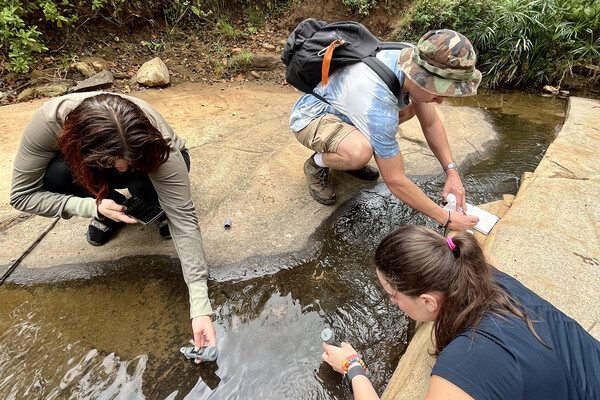
Griffin Pitt, right, works with two other student researchers to test the conductivity, total dissolved solids, salinity, and temperature of water below a sand dam in Kenya.
(Image: Courtesy of Griffin Pitt)

A few years ago Wendy Steiner, the Richard L. Fisher Professor of English, found herself teaching a class on Chaucer’s “Canterbury Tales.” When she came to the Wife of Bath’s Tale—about a knight who is condemned to death unless he can find the answer to the question “What do women want most?”—she marveled anew at the story’s beautiful structure and tightly drawn plot.
“It just kept tugging at me,” says Steiner. “Words started forming.” Before she knew it she was writing the libretto for a Chaucerian opera and getting ever more intrigued about the idea. “I realized there weren’t any Chaucerian operas, whereas Shakespeare was all over the place.”
This summer in New York and Philadelphia, Steiner presented a seven-minute pilot preview of “The Loathly Lady,” her animated opera based on Chaucer’s tale.
In Steiner’s version, the hapless knight seeks advice from Merlin and Freud and interviews a series of opinionated women—from Jane Austen’s Emma, to Scheherezade, to the Lady of Shalott and Virginia Woolf and, finally, the Loathly Lady of the title—to find the answer to the question and save his life.
Steiner is as surprised as anybody that her germ of an idea grew into an animated film that brought her into collaboration with an artist, a musician and a digital animator. As she tells it, her serendipitous tale took flight when she mentioned her idea to her music teacher John DeLucia, a specialist in early music (who later became the project’s musical director). At DeLucia’s urging, she looked for a composer and found Paul Richards, a music professor at the University of Florida in Gainseville. Richards’ idea was to adapt the opera’s musical idiom to the different time periods through which the knight travels, using such early instruments as the sacbut, shawm, dulcian, rebec and viola da gamba. For the early court scenes, then, we hear traditional Ars Nova. By the time Scheherezade turns up, the music has transitioned to a tango. And when Jane Austen’s Emma appears on the scene, she is accompanied by a lively English country dance.
The next step, says Steiner, was to find “wonderful singers who represented the range of vocal types we needed to reflect the different periods.” For the queen who gives the knight his challenging assignment, she settled on the “beautiful, pure tone” of Susan Hellauer, a member of Anonymous 4, a vocal ensemble known for its interpretations of medieval masses and early music.
For Merlin, she picked a high countertenor “because he has to sound magical,” and for Freud a Wagnerian tenor with the “ham fisted and heavy” quality she was seeking. The knight, who “never quite gets it,” says Steiner, was brought to life by a Broadway baritone.
Steiner’s artist friend John Kindness, who lives in London, agreed to create the drawings and for the animation she turned to Joshua Mosley, associate professor of fine arts, animation and digital media in the School of Design.
Putting together the pilot, with which she hopes to drum up interest among production companies to fund a full-length film, was “tremendous fun” says Steiner. “We sat at the computer with the soundtrack and we chopped it up to create the seven-minute pilot and we stuck in the still images and a few effects.”
Steiner says coordinating the project, with an artist in London, an animator in Philadelphia, musicians in New York and a composer in Florida was massively complicated but ultimately successful. “It was kind of a piece of magic in itself. Every professional who hears about it rolls his eyes.”
And what do women want most? You’ll have to wait for the full-length feature to find the answer to that question.
Originally published on September 7, 2006.

Griffin Pitt, right, works with two other student researchers to test the conductivity, total dissolved solids, salinity, and temperature of water below a sand dam in Kenya.
(Image: Courtesy of Griffin Pitt)

Image: Andriy Onufriyenko via Getty Images

nocred

Provost John L. Jackson Jr.
nocred